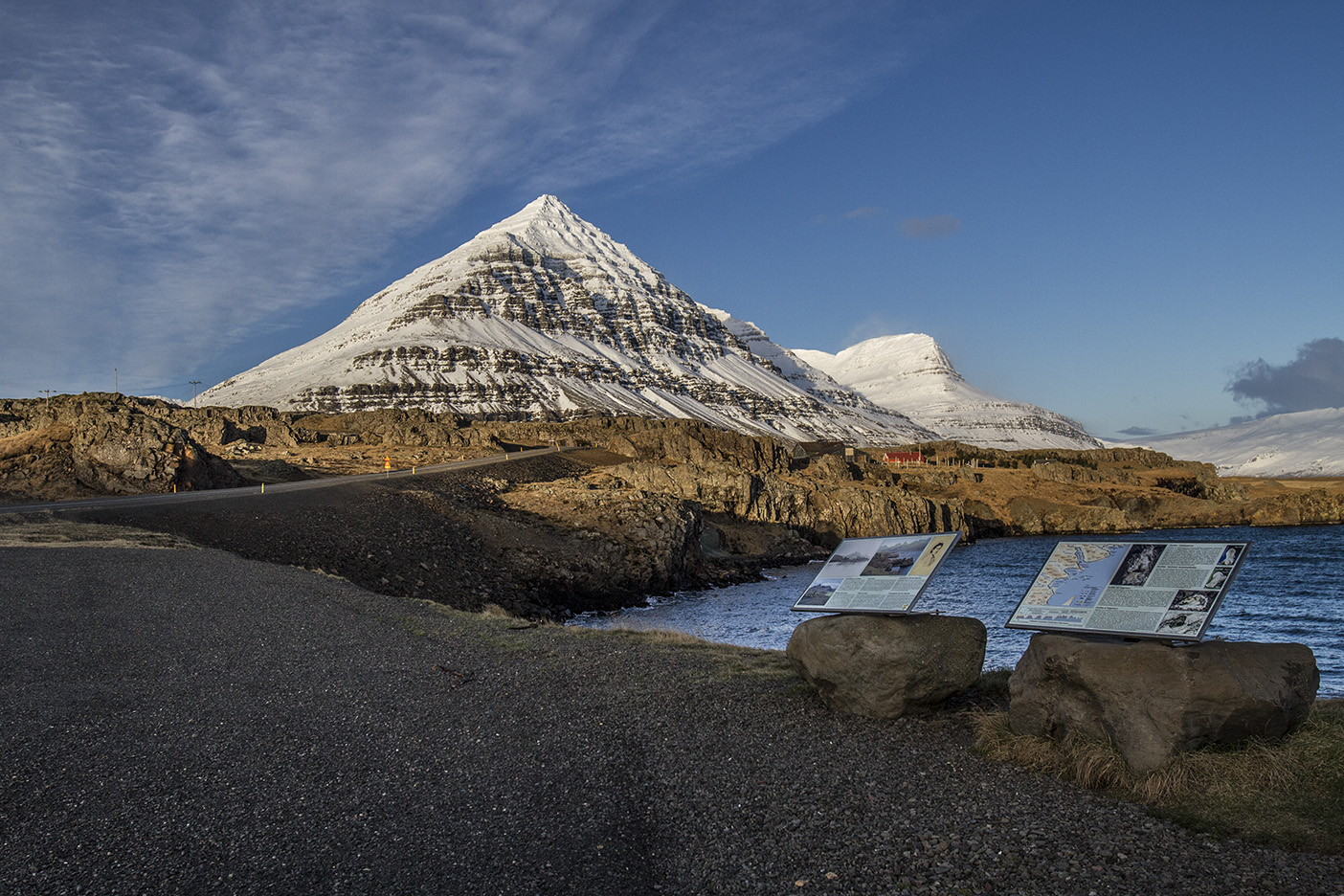Vinna við nýjar heimasíður Umhverfis- og orkustofnunar og Náttúruverndarstofnunar er í gangi. Heimasíða Umhverfisstofnunar er virk á meðan vinnunni stendur. Information in English
Teigarhorn

Teigarhorn has been protected as a natural monument since 1975, and that protection was renewed on 15 April 2013. The area is one of best known places where zeolites are found in the world. Zeolites occur in rocks and cliffs in Teigarhorn and are occasionally exposed by weathering. Unauthorised persons are prohibited from disturbing geological formations. Teigarhorn is best known for the zeolite types scolecite, stilbite, epistilbite, analcime and heulandite. The aim of the protection is to preserve and maintain the natural conditions of the area, in regards to the zeolite-rich strata.
The Teigarhorn farm has also been protected since 15 April 2013 as a country park. Teigarhorn farm is known for geological formations and industrial and cultural history. Within the property boundaries is the Weywadt House, built by Niels P.E. Weywadt, director of the Ørum and Wulff general store in Djúpivogur. Teigarhorn was the site of Nicoline Weywadt’s photography studio. She was first woman in Iceland to study photography and graduated from Denmark in 1872. Also within the boundaries of the country park is the natural monument Teigarhorn, protected because of the zeolites found there. The aim of the protection of the farm is to ensure an outdoor recreational area in a beautiful setting where visitors have the opportunity to get to know the unique nature of the area and the history of the Teigarhorn farm.
The country park covers an area of 2010 ha.
Cultural Heritage
There are many cultural heritage sites on the Teigarhorn grounds that attest to the farming practices on the farm. First and foremost, there is the old residential building, the Weywadt House, built in 1880–1882 by the joiner Lúðvík Jón Jónsson for Niels Peder Weywadt, the director of the Ørum and Wulff general store in Djúpivogur. His daughter, Nicole Marie Elise Weywadt, studied photography in Copenhagen, the first Icelandic woman to do so, and ran a photography studio in the annex building of the house. Her photographs and various photography equipment are preserved by the Photo Gallery of the National Museum of Iceland.
[JJ2] , a rarity in Iceland. Underneath the house is a drystack basement, a raised second floor and storage space in the attic. The building footprint is approximately 65 m2. The National Museum of Iceland took over custody of the house in 1992, as the house had been inhabited until 1988, or for over 100 years.
Meteorological observations have been systematically conducted in Teigarhorn since 1881, making the site an important part of the history of meteorological observations in Iceland. The highest temperature ever recorded in Iceland was 30.5°C in Teigarhorn on 22 June 1939.
Other relics of farming practices on the Teigarhorn farm are related to both seafaring and traditional farming. A list of these relics has been compiled, but an official archaeological heritage registry has not been made. Examples include the ruins of the old Teigarhorn farm, an old fish shed, a circular drystack sheep corral, the foundations of a grain mill, the Kerlingastaðir ornamental garden, the ruins of old livestock housing and drystack walls. A Place Name Register has been made for Teigarhorn, but it has not been entered into a base map.
Points of Interest
Teigarhorn is by the Berufjörður fjord. Approached from the north, the area is around 3 km before you reach the Djúpivogur exit. Parking for visitors is by the residential buildings, but there is also a recess in the Eyfreyjunesvík road, just outside the protected area once you pass the farm, where you'll get a view over the whole area.
Teigarhorn has a small museum with an exhibition of the local zeolites that is open to visitors. The museum also has toilet facilities. The farm has an eiderdown shed where a ranger will offer regular lectures on the eider duck and eiderdown harvesting in the summer.
Hiking trails have been marked on Teigarhorn and can be seen on the hiking trail map. There is also a well-known hiking trail on Búlandstindur that has been featured in hiking guides. The trail, however, is not signposted.
Rules of Conduct
- General access to the area is allowed provided that visitors conduct themselves properly.
- Dogs must be on a leash, except working dogs.
- Camping in the area is prohibited.
- Off-road driving is prohibited.
- Disturbing, or damaging in any way, the geological formations and cultural heritage of the area is prohibited.
- Removing zeolites from the area without the permission of the Environmental Agency of Iceland is prohibited.
- Grazing is only permitted in fenced, cultivated pastures and in Búlandsdalur.
- Extraction from the Búlandsá riverbed is prohibited.
- Cultivation and distribution of exotic plants is prohibited in the country park.
- Reindeer and ptarmigan hunting is only allowed in Búlandsdalur. The use of vehicles while hunting in the area is prohibited.
- All use of firearms must be reported to the local supervisor.
- All motor vehicle traffic in the natural monument is prohibited.
Administration – Operation/Management
Part of the Teigarhorn farm was protected as a natural monument in 1975. The protection was reviewed in 2013, and the protection of the Teigarhorn country park, which covers all the Teigarhorn grounds, was signed.
As a rule, the Environment Agency of Iceland manages protected areas. The municipality of Djúpavogshreppur, however, was entrusted with the daily management and operation of the Teigarhorn areas in a 2013 agreement.
The national monument zeolite on the Teigarhorn land is on the orange list of endangered areas.